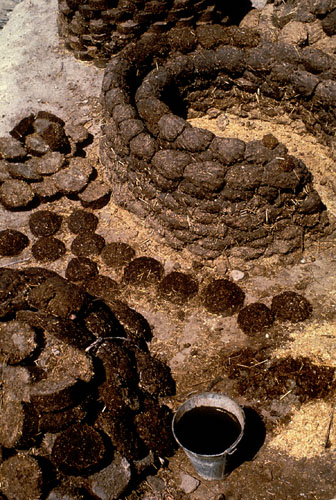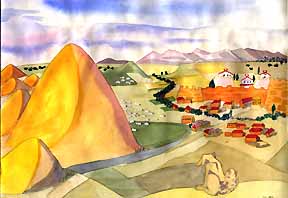Museum Applied Science Center for Archaeology
Archaeological Science at the Penn Museum
DRAFT of August 9 , 2007
The Museum Applied Science Center for Archaeology (MASCA) began
under the direction of physicist Elizabeth Ralph [photo?] in 1961. Its
primary focus was to advance understanding of the then-new technique of
radiocarbon-dating. This work was informed by dendrochronological studies
carried out by Henry
Michael [photo, w/ bristlecone pine?]. Our second Scientific Director,
physicist Stuart J.
Fleming, took a much broader view of the field; his vision was to
apply scientific techniques to
anthropological questions. As the field of archaeology has evolved,
MASCA, too, has changed. Our scientific studies now focus on human
transformation of the material world in three broad overlapping
categories: landscape, food, and materials. Humans change landforms into
landscape, biota into food, and minerals into metalwork and ceramics.
Practitioners dealing with the physical (rather than symbolic)
transformation of land, food, and materials might use GIS, archaeological
survey, archaeobiology (archaeobotany and zooarchaeology), organic
residue analysis, metallography, petrography, etc. Because physical
transformation requires the expenditure of energy, our research looks to
the future as well as the past.
? LINK: History of MASCA ...is there an article in Expedition we
can link to? include old MASCATEERS as where are they now?
Archaeobiology at MASCA
[photos of plants, animals, and people?]
What is archaeobiology?
Archaeobiology is the combined and integrated analysis of plant
and animal remains from archaeological sites. Archaeobiology is rooted in
human-land relationships, the core of many historical processes.
Civilizations rise and fall not only for political reasons, but also
sometimes for ecological ones. Ancient decisions about agriculture,
grazing, fuel-cutting, irrigation, and associated water management,
especially in an arid environment are reflected in archaeobiological data
such as charred seeds and bones. Not only do these remains help us
understand the past, they mat also inform discussions of land use today.
To achieve a deep-time understanding of such processes, archaeology is a
key discipline; through excavation and field sampling, archaeologists
provide important data and material from archaeological sites.
[LINK to 2008 conference?]
What questions do archaeobiologists ask?
- Who drank the first cup of milk? How many places did milk
drinking begin?
- Did human action or climate change destroy the early forests of
the Middle East?
- Can dogs alter the interpretation of prehistory just by gnawing?
- How do pastoral peoples manage the health of their animals and
work to provide them with adequate pastures?
- How do farmers and herders learn how to deal with the risk of
hard times?
- How can archaeologists help modern communities understand
contemporary ecological changes and opportunities?
Where we do field work
- East Africa
Kathleen Ryan heads a project in Kenya focussed on the origins of
pastoralism in collaboration with the Karega Muñene (Kenya
National Museum). Her ethnoarchaeological work with Maasai cattle-herders
has provided models that guide current and future excavation: [photos?]
ethnomedine, Prehistoric
cattle-herders on the Laikipia Plateau, Kenya
- North America
University of Pennsylvania graduate student Teagan Schweitzer is
analyzing animal bone from features underneath historic Philadelphia in
collaboration with the National Park Service. Her work examines the
emergence of a typical American cuisine as a hallmark of American
identity in the period 1750-1850.
- South America
Katherine M. Moore leads a team of zooarchaeologists for the
Taraco Archaeological Project, Christine Hastorf (UC-Berkeley) director.
Work on the early Bolivian centers of Chiripa and Kala Uyuni have shown
the process of domestication and breeding, specialized fishing, and the
history of the lakeshore landscape. In this project, zooarchaeologists
collaborate with paleoethnobotanists, isotope specialists,
geoarchaeologists, and archaeologists working on ceramics and lithics.
[photos?]
University of Pennsylvania graduate student Kristen Gardella is
analyzing animal bone remains from Tiwanaku, the major political and
ceremonial center of ancient Bolivia, in collaboration with Jason Yaeger
(University of Wisconsin) and Alexei Vranich (Dumbarton Oaks). Her
dissertation will address the organization and ecology of animal
production in the economy of an early state.
- West Asia
 Naomi F. Miller's
research focuses on long-term human impact on the landscape. Her
realization that many seeds from west Asian archaeological sites
originated in animal dung burned as fuel informs much of her research.
Naomi F. Miller's
research focuses on long-term human impact on the landscape. Her
realization that many seeds from west Asian archaeological sites
originated in animal dung burned as fuel informs much of her research.
 Her main current field project is at Gordion, Turkey.
In addition to archaeobotanical analysis, she is using her expertise to
advise on using plants to help preserve the ruins as well as to educate
visitors about the natural history of the region, a project she
optimistically calls the Ecopark.
Her main current field project is at Gordion, Turkey.
In addition to archaeobotanical analysis, she is using her expertise to
advise on using plants to help preserve the ruins as well as to educate
visitors about the natural history of the region, a project she
optimistically calls the Ecopark.
- Central Asia
Naomi F. Miller and Katherine M. Moore are actively collaborating
at the site of Anau, Turkmenistan. Bones, seeds, and wood charcoal have
already documented the desert oasis economy based on sheep-herding and
irrigation agriculture. Ongoing study will relate changes over time in
the subsistence economy to population shifts and urbanization. [photos,
captions?]
â
Where we do laboratory work
- The MASCA zooarchaeology
laboratory is home to a collection of modern animal skeletons, an
archive of bone specimens from experiments for taphonomic work, and
equipment and workspace for research on prehistoric animal bones. Our
collection of more than 65 skeletons allows work on most of the important
animals in North America, Europe and Western Asia, and Andean America,
and is always increasing. We collaborate with colleagues at the Academy
of Natural Sciences in Philadelphia to borrow and visit specimen for rare
identifications. Moore teaches courses in zooarchaeology and the
archaeology of food, and supervises students who work on independent
projects. We advise and support sections of the museum that curate
objects and artifacts made of animal material. Scholars and students l
visit to consult the comparative collections and the taphonomy archive.
We recently established new extramural collaborations for our project in
Kenya. We seek to support the development of zooarchaeology in South
America, and have contributed to local websites (Arqueobios)
- The MASCA archaeobotany
laboratory hosts occasional visiting students and scholars who wish
to work with the botanical comparative collection, with strongest
holdings of seeds and wood for the southern Zagros, Iran, and central
Anatolia. Recent projects of Miller and visitors
involved analysis of seeds and charcoal from Iran and Turkey.
Biomolecular Archaeology at MASCA
The Biomolecular Archaeology
Laboratory continues to pursue state-of-the-art research on ancient
organic materials, with the help of a Research Associate analytical
chemist and students. Highly effective outside collaborations have
expanded the laboratory's capabilities in the past three years. The
laboratory is equipped with an FTIR mass spectrometer...or whatever that
thing is
Where we work
- Patrick E. McGovern travels extensively in Eurasia, from Georgia
to China, in his never-ending quest for samples of wine residues....
Archaeoceramics at MASCA
The archaeoceramics program includes on-going collaborations
within the University and beyond. In-house we have a petrographic microscope.
Examples of our projects
Archaeometallurgy at MASCA
The archaeometallurgy program focuses on the metal technology
used to manufacture artifacts in the Penn Museum's extensive collections
under the general supervision of Stuart Fleming (emeritus). We benefit
from the expertise of several volunteers (retired metallurgists) and a
work-study student.
Examples of our projects
Landscape Studies and Mapping at MASCA
Our computer laboratory is currently in use by several
work-studies in several of our sections, and the
quantitative/computational/GIS program is
also based there. We support the ... software for archaeological mapping
and planning at all scales, from site to region. We are
consulting/assisting several archival digitization projects for old Penn
Museum excavations.
Where we work
- Our computer lab is supporting the Ayse Gursan-Salzmann's
stratigraphic re-analysis of archival material from Hissar, Iran.
- We are also supporting the Gordion digitization project.
- Researchers who use our software work on Penn Museum projects
(Abydos, etc.) and outside projects (...)
 Naomi F. Miller's
research focuses on long-term human impact on the landscape. Her
realization that many seeds from west Asian archaeological sites
originated in animal dung burned as fuel informs much of her research.
Naomi F. Miller's
research focuses on long-term human impact on the landscape. Her
realization that many seeds from west Asian archaeological sites
originated in animal dung burned as fuel informs much of her research.  Her main current field project is at Gordion, Turkey.
In addition to archaeobotanical analysis, she is using her expertise to
advise on using plants to help preserve the ruins as well as to educate
visitors about the natural history of the region, a project she
optimistically calls the Ecopark.
Her main current field project is at Gordion, Turkey.
In addition to archaeobotanical analysis, she is using her expertise to
advise on using plants to help preserve the ruins as well as to educate
visitors about the natural history of the region, a project she
optimistically calls the Ecopark.